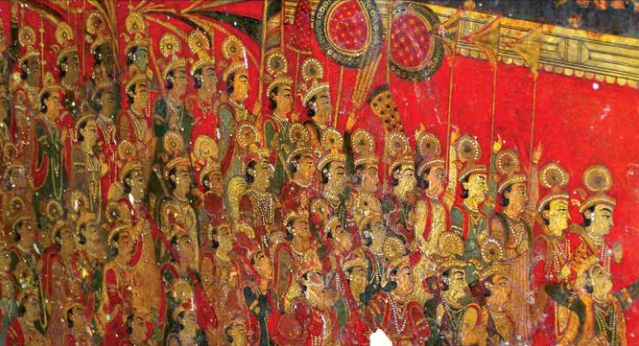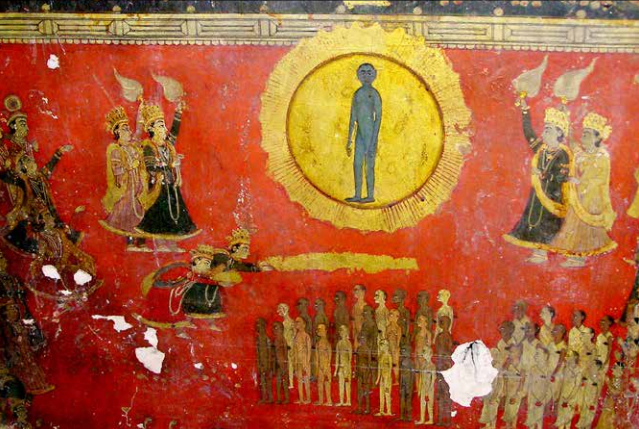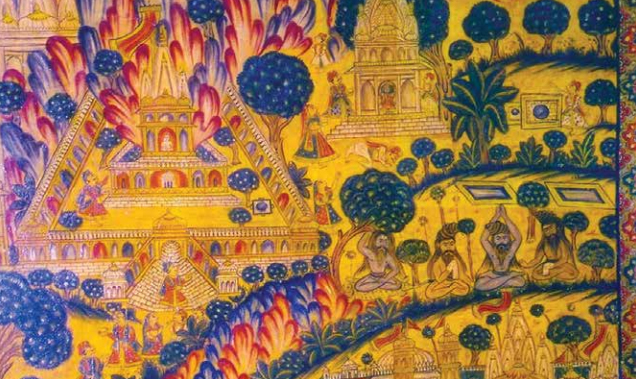
Centre of Jaina Studies Newsletter: SOAS - University of London
Malwa (Mālavā) has a rich heritage of Indian painting, including Jaina subjects. The famous Bāgh caves in Malwa were painted in the style of the Ajantā tradition in the 5th-6th centuries. Kālidāsa (ca. 5th century), who is considered to be a native of Ujjain, wrote in detail about painting. Rājā Bhoja (11th century CE), a scholar and Paramār ruler of Malwa, wrote about painting in his famous work on architecture, Samarāṅgaṇāsūtradhāra. According to the art historian Rai Krishna Das, the painting tradition continued until the reign of Rājā Udayāditya in the 11th to 12th centuries.[1] Although many examples are no longer extant, it can be concluded that the tradition of painting, particularly wall painting, flourished in Malwa at different times. This conjecture can be further supported by the following evidence of murals from the late medieval period, which to date have not yet been described.
Śāntinātha Digambara Jaina Atiśaya-Kṣetra Bajaraṅgagaḍha
Bajaraṅgagaḍh (Bajranggarh), also known as Jhārakona, a small village located 7 km south of the city of Gunā in Madhya Pradesh, is known as an atiśaya-kṣetra, or site of miracles. The miraculous idols of the Tīrthaṅkaras Śāntinātha, Kunthunātha and Aranātha in standing postures were sculpted by one Śreṣṭhī, named Pādaśāha, in Vikram Saṃvat 1236 (1179 CE). They were enshrined in a temple known as Śāntinātha Digambara Jaina Atiśaya Kṣetra Bajaraṅgagaḍh, which was constructed by one Śreṣṭhī, named Pādaśāha, in Vikram Saṃvat 1236 (1179 CE).[2]

Figure 2. Mural in the Śāntinātha Digambara Jaina Atiśaya Kṣetra in Bajaraṅgagaḍh, 2009.

Figure 1. Mural in the Śāntinātha Digambara Jaina Atiśaya Kṣetra in Bajaraṅgagaḍh (M.P.), 2009.
The paintings on the walls of the main temple in which the statues of the three Tīrthaṅkaras were enshrined offered a panoramic view of the pilgrimage site Sammedśikharajī. Its name was inscribed in Nāgarī as Śrī Sammedsikarajī kau Nakasā (Naqśā), 'Map of Sammedśikharajī'. A section of this mural depicted a scene of worship (Figure 1). In one mural, the welcoming and veneration of the Jina by the fourfold community was shown, with the Jina placed in a golden halo, representing enlightenment, and uniquely depicting two groups of monks, Digambara and Mūrtipūjaka, as well as groups of female and male devotees. Adjacent to this one, a naked Tīrthaṅkara in a sitting posture was shown, encircled by members of the fourfold Jaina community along with animals, all welcoming and venerating him. In another mural, a Tirthaṅkara was shown. There was a dividing line between the groups and 'Kalpavāsa' was inscribed on the wall. Kalpavāsa means to live with forbearance, and the same was pictured on the walls.
These paintings appeared to have been influenced by the Bundelkhaṇḍ idiom. The moustaches were identical to those in the paintings of Orachā, Datiyā and Ajayagaḍh, where many paintings on paper and on walls were created during the medieval and early modern periods. The costumes, ornaments and jeweled crowns over the heads 2 In 2003 the present author was able to view and photograph these murals for the first time and again in 2009. of the devotees were painted with attention to fine detail (Figure 2). They were depicted wearing mālās or small garlands of pearls around their necks. The profiles were proportionate and their slim, young bodies were painted in light red. The men wore a long cloth, an uparṇā or dupaṭṭā, over their right arm. The costumes of some devotees were painted in green.
The motifs of the Orachā painting tradition were also copied with little variations. We observed fine inlay work in the depiction of the Tīrthaṅkara in a sitting posture. There were conical bricks, hoisting flags, peacocks and unique floral designs.
It may be concluded that these murals were painted either in the last decades of 18th century or in the early 19th century. During this period Bajaraṅgagaḍh was under the domination of the Khīcī rulers of Rāghogaḍh, which explains why these paintings were influenced by the style of Rāghogaḍh. This style was an amalgam of influences from Bundī, Koṭā and Mevāṛ (Mewar). The paintings would have been produced by the artists of Rajasthan, and by the local artists of Rāghogaḍh. Rajasthani features were particularly evident in the emerging banana trees, the signature symbol of the Bundī and Koṭā styles. Thus, this remarkable work was the product of artists of eastern Malwa, representing the assimilation of Bundelkhaṇḍ, Rāghogaḍh and Rajasthani painting styles, particularly those of Bundī and Koṭā of Rajasthan.
Śāntinātha Jaina Temple in Ratlām
The western region of Malwa is adjacent to the Mewar region of Rajasthan. The Malwa and Mewar painting traditions have influenced each other to a great extent over centuries. In the western Malwa region the Mewar style is dominant.
There is a Jaina temple in Ratlam, which is known both as the Agarajī Mandira and the Śāntinātha Jaina Mandira. It was built in 1790 CE by Agarajī, an ascetic (jatī) under the patronage of the royal court (darbār) of Ratlām, which also made a grant of a share of certain custom charges to the temple in 1790 and 1796. It also provided a a grant of rent-free lands (māfī) for the maintenance of the temple. There is an inscription on the gate that includes the name Mahārājā Parbat Siṅgh (r. 1800-1825), indicating that he might have made additional grants to the temple. There are murals on the walls, painted in red, showing the influence of Rajasthani wall paintings. This in not unusual as Ratlam is adjacent to Bānsvāṛā and Udaipur. These murals are likely to have been painted in the earlier decades of 19th century, influenced by the Mewar style. Paintings were also produced in niches.
The main features of this style are stout human figures, lush vegetation and Rajasthani architecture. Many of the depictions are of traditional Hindu subjects, but Jaina subjects are also evident, for example an image of Ambikā shown with a deer next to a child who is looking towards her. We also find depictions of Jaina monks, Tīrthaṅkaras and yakṣīs having wings that have been proportionately painted. A monk is seated and preaching to disciples standing before him. The Tīrthaṅkara is sitting in padmāsana and two worshippers, a male and female, a royal couple, are seen standing left and right of the Tīrthaṅkara.

Figure 3.Painting of Jaina temples at Pāvapuri and of Śivaite hermits engaged in yoga, Baṛe Bābājī Temple, Ratlām.
Bābājī Temple in Ratlām
An example of a Jaina temple with murals that are still preserved and in good condition is the Bābājī Mandira, situated in the center of Ratlam. These paintings, likely painted in the early decades of 19th century, have a clear Mewar influence. The exact history of the temple is not known, but it is likely that the temple was constructed in the 18th century. The murals would have been executed later, probably in the first half of the 19th century.
The main walls of the temple are painted and the colours are still vibrant. (Figure 3) A painting of Pāvāpurī, the place where Mahāvīra's reached nirvāṇa, is well executed with 'Pāvāpurī' inscribed on it. There are small figures of the pilgrims visiting this temple depicted on the wall, and scenes of the temple showing the hoisting of flags, towers, trees and women, painted in Mewar style. The Śreṣṭhīs are shown in traditional dresses. In one painting a goddess is seen enshrined and two royal ladies are worshipping her. The use of magenta is typical of the style adopted by medieval artists in the central Indian region, particularly Rāghogaḍh. This style then travelled from Malwa to the Deccan, and continued to be employed.
The murals in this temple depict a number of activities.
We find the idol of Bhagavāna Pārśvanātha enshrined, and a couple worshipping it. There are chariots, ponds and houses surrounded by banana and banyan trees. In the surrounding fields four Śivaite hermits are depicted engaged in their meditation in yoga postures. In another painting a furious elephant can be seen along with some spectators looking at the animal with fear. There are boats in the pond and number of activities are shown in the lower panel of the painting.
As discussed above, the paintings of Bajaraṅgagaḍh are now unfortunately no more in existence but it is clear that the painting style of the eastern Malwa region was distinct in many ways from the Jaina murals painted in the western region of Malwa. The eastern Malwa Jaina murals were influenced by the Orachā mural tradition and Bundī, Koṭā and Rāghogaḍh as well, while the paintings of Ratlam though late, have an apparent influence of the Mewar idiom. The survey of Malwa Jaina paintings opens new gates for the observation and study of the rich heritage of the Jain community of Malwa.
Narmada Prasad Upadhyaya is an independent researcher of Indian miniature paintings, particularly central Indian paintings. He has written extensively on the Jaina painting tradition and is currently working on the illustrated manuscripts of the Bhaktamara Stotra. He lives in Indore (Madhyapradesh). E-mail: [email protected]